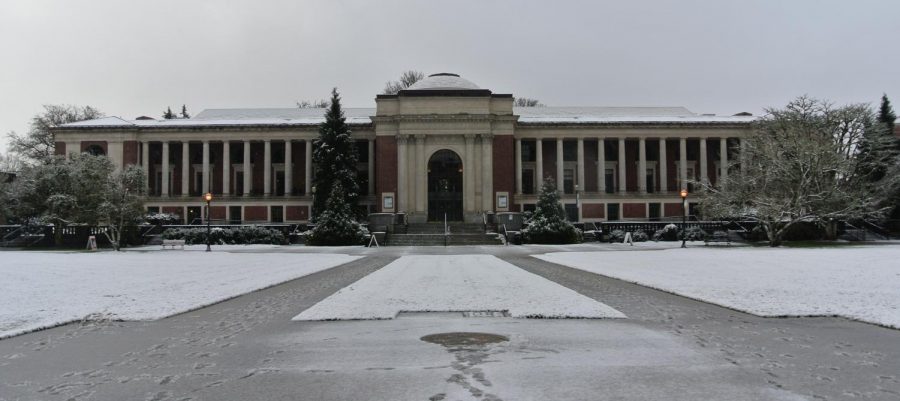Watching the weather
March 20, 2017
Students awaken to see snow yet again sprinkled across campus; some anxiously waited for Oregon State University to either delay or close completely, as they have in the past.
No email notification was sent out to students and the campus remained open. OSU did however send out a tweet: “Good morning. Corvallis campus operations will run as normal today. Please use personal discretion navigating to and from campus.”
This is exactly what happened on Monday, March 6. The campus remained open while the Corvallis School District had a two-hour delay, which calls into question, what exactly is OSU’s closure policy, and how does the campus notify students?
Steve Clark, vice president of university relations and marketing at OSU, said the decision to close campus is made jointly by the Provost, the Vice President of Finance and Administration and himself.
According to Clark, a number of factors are considered for closures.
“We intently follow NOAA (National Oceanic and Atmospheric Administration) weather forecasting services, the National Weather Service and local weather forecasters,” Clark said.
If a decision to close or delay is made, OSU uses the ‘Timely Alert System,’ which notifies students via email.
On March 6, that was not the case. OSU representatives decided a closure was not necessary as temperatures were expected to rise above freezing and melt the snow quickly. They then sent out the tweet advising students to travel safely.
OSU student Susan Rowe said she had not seen the tweet because she prefers other forms of communication.
“It’s one of the social media things that I don’t have,” Rowe said.
This is not an isolated opinion. According to OSU student Christine Melancon, she would prefer to receive emails for weather-related incidents as well.
“I don’t have a Twitter, but I check my email every day.”
Twitter and email are not the only mediums OSU uses to report weather interruptions on campus. Clark explained there are various ways the university can choose to notify its students.
“We send emails to all faculty, staff and students; provide information on the OSU home web page; utilize social media messaging; and provide news alerts to local media for publication or broadcasting,” Clark said.
Some believe that OSU follows the Corvallis School District when deciding to close or delay. However, according to Clark that is not always the case.
“Unlike a K-12 school district that has schools in many varied locations, Oregon State’s operations in Corvallis are largely in one area,” Clark said.
The Corvallis School District must cater to the needs of younger students in multiple areas. This can lead to public school closures while OSU remains open, as evidenced by the C.S.D. two-hour delay on March 6.
Public school students are alerted of closures through the emergency notification system and the local media. Brenda Downum, communications coordinator at the Corvallis School District, said bus routes are taken into
consideration for closures.
“Due to early bus routes, we typically make a decision by 5:30 a.m.,” Downum said.
The university has more leeway, as its closure is specific to one location. OSU does try to decide closures or delays early enough so that they don’t disrupt travel. Clark said the university tries to announce before 5:30-6 a.m., but the school has also cancelled classes the night before and even in the middle of the day.
On March 6, the system worked according to plan as no actual closure took place. According to Clark, in the future students are advised to check OSU’s homepage, closures will always be reported there.
“Over the past several years, we have consistently informed students and employees to check the OSU homepage for weather updates or closure information regarding inclement weather,” Clark said. “We feel doing so allows students and employees to have a role themselves in being informed.”











































































































